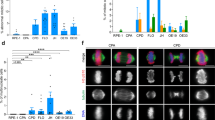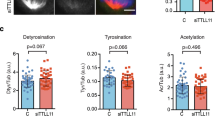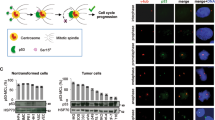Abstract
Mutations in the Adenomatous Polyposis Coli (APC) gene are responsible for familial colon cancer and also occur in the early stages of sporadic colon cancer1. APC functions in the Wnt signalling pathway to regulate the degradation of β-catenin (reviewed in refs 1–3). APC also binds to and stabilizes microtubules in vivo and in vitro4, localizes to clusters at the ends of microtubules near the plasma membrane of interphase cells5,6, and is an important regulator of cytoskeletal function7,8. Here we show that cells carrying a truncated APC gene (Min)9 are defective in chromosome segregation. Moreover, during mitosis, APC localizes to the ends of microtubules embedded in kinetochores and forms a complex with the checkpoint proteins Bub1 and Bub3. In vitro, APC is a high-affinity substrate for Bub kinases. Our data are consistent with a role for APC in kinetochore–microtubule attachment and suggest that truncations in APC that eliminate microtubule binding may contribute to chromosomal instability in cancer cells10.
This is a preview of subscription content, access via your institution
Access options
Subscribe to this journal
Receive 12 print issues and online access
$209.00 per year
only $17.42 per issue
Buy this article
- Purchase on Springer Link
- Instant access to full article PDF
Prices may be subject to local taxes which are calculated during checkout




Similar content being viewed by others
References
Kinzler, W. K. & Vogelstein, B. Cell 87, 159–170 (1996).
McCartney, B. M. & Peifer, M. Nature Cell Biol. 2, E58–E60 (2000).
Peifer, M. & Polakis, P. Science 287, 1606–1609 (2000).
Zumbrunn, J., Inoshita, K., Hyman, A. A. & Näthke, I. S. Curr. Biol. 11, 44–49 (2000).
Näthke, I. S., Adams, C. L., Polakis, P., Sellin, J. H. & Nelson, W. J. J. Cell Biol. 134, 165–179 (1996).
Mimori-Kiyosue, Y., Shiina, N. & Tsukita, S. J. Cell Biol. 148, 505–517 (2000).
McCartney, B. M. et al. J. Cell Biol. 146, 1303–1318 (1999).
Yu, X., Waltzer, L. & Bienz, M. Nature Cell Biol. 1, 144–151 (1999).
Su, L. K. et al. Science 256, 668–670 (1992).
Lengauer, C., Kinzler, K. & Vogelstein, B. Nature 396, 643–649 (1998).
Earnshaw, W. C. & Rothfield, N. Chromosoma 91, 313–321 (1985).
Martinez Exposito, M., Kaplan, K., Copeland, J. & Sorger, P. Proc. Natl Acad. Sci. USA 96, 8493–8498 (1999).
Dobles, M., Libertal, V., Scott, M. L., Benezra, R. & Sorger, P. K. Cell 101, 635–645 (2000).
Kalitsis, P., Earle, E., Fowler, K. J. & Choo, K. H. Genes Dev. 14, 2277–2282 (2000).
Cahill, D. P. et al. Nature 392, 300–303 (1998).
Morgenstern, J. P. & Land, H. Nucleic Acid Res. 18, 3587–3596 (1990).
Rubinfeld, B. et al. Science 272, 1023–1026 (1996).
Hanks, S. K. & Junter, T. FASEB J. 9, 576–596 (1995).
Acknowledgements
We thank the Marine Biological Laboratory, R. Weinberg, J. Copeland, the T. J. Mitchison laboratory and the Human Cytogenetics Group at Ninewells Hospital for help, and members of the I.S.N. laboratory and K. Storey for critical reading of the manuscript. A substantial portion of this work was carried out at UC Davis with the support of the American Cancer Society. This work was also supported by grants from the NIH and Merck (to P.K.S.) and from the Wellcome Trust and the Cancer Research Campaign (to J.R.S.), and by a Cancer Research Campaign Senior Fellowship and a Burroughs Wellcome Career Development Award to I.S.N.
Author information
Authors and Affiliations
Corresponding author
Rights and permissions
About this article
Cite this article
Kaplan, K., Burds, A., Swedlow, J. et al. A role for the Adenomatous Polyposis Coli protein in chromosome segregation. Nat Cell Biol 3, 429–432 (2001). https://doi.org/10.1038/35070123
Received:
Revised:
Accepted:
Published:
Issue Date:
DOI: https://doi.org/10.1038/35070123
This article is cited by
-
Role of adenomatous polyposis coli in proliferation and differentiation of colon epithelial cells in organoid culture
Scientific Reports (2021)
-
Degree and site of chromosomal instability define its oncogenic potential
Nature Communications (2020)
-
PLK1 has tumor-suppressive potential in APC-truncated colon cancer cells
Nature Communications (2018)
-
Novel APC gene mutations associated with protein alteration in diffuse type gastric cancer
BMC Medical Genetics (2017)
-
Metazoan evolution of the armadillo repeat superfamily
Cellular and Molecular Life Sciences (2017)



